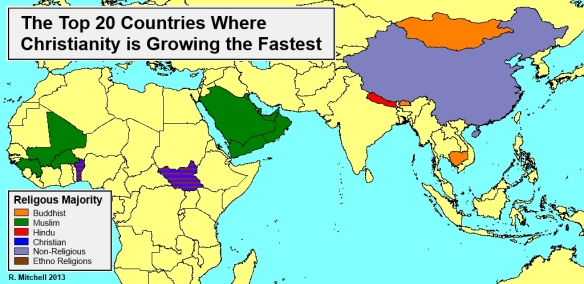Where is Christianity growing the fastest? The Center for the Study of Global Christianity, based at Gordon Conwell Seminary, published In June 2013 an excellent report regarding Christianity in its Global Context. The full report can be found online atwww.globalchristianity.org/globalcontext. From this report I identified the top 20 countries that have the highest percentage Christianity Average Annual Growth Rate (AAGR). They are listed in Table 1. I have also calculated the number of years for the number of Christians to double, based on the Average Annual Growth Rate.
Table 1. The Top 20 Countries Where Christianity Has the Highest Percentage Growth Rate
| Rank | Country | Continent | Christian AAGR | Years to double | Majority Religion | Percent Christian 1970 | Percent Christian 2020 |
|
1 |
Nepal | Asia, South Central |
10.93% |
6.6 |
Hindu |
0.1% |
3.8% |
|
2 |
China | Asia, Eastern |
10.86% |
6.6 |
Non-religious |
0.1% |
10.6% |
|
3 |
United Arab Emirates | Arabian Peninsula |
9.34% |
7.7 |
Muslim |
5.9% |
12.9% |
|
4 |
Saudi Arabia | Arabian Peninsula |
9.27% |
7.8 |
Muslim |
0.3% |
4.6% |
|
5 |
Qatar | Arabian Peninsula |
7.81% |
9.2 |
Muslim |
4.5% |
9.5% |
|
6 |
Oman | Arabian Peninsula |
7.62% |
9.4 |
Muslim |
0.5% |
4.6% |
|
7 |
Yemen | Arabian Peninsula |
7.09% |
9.1 |
Muslim |
0.0% |
0.2% |
|
8 |
Mongolia | Asia, Eastern |
5.96% |
12.1 |
Buddhist |
0.3% |
2.0% |
|
9 |
Cambodia | Asia, South-eastern |
5.87% |
12.3 |
Buddhist |
0.5% |
3.6% |
|
10 |
Bahrain | Arabian Peninsula |
5.49% |
13.1 |
Muslim |
3.9% |
7.9% |
|
11 |
Benin | Africa, Western |
4.85% |
14.8 |
Christian |
18.1% |
47.8% |
|
12 |
Burkina Faso | Africa, Western |
4.81% |
15.0 |
Muslim |
9.0% |
24.8% |
|
13 |
South Sudan | Africa, Eastern |
4.67% |
15.4 |
Christian |
22.7% |
63.8% |
|
14 |
Bhutan | Asia, South Central |
4.60% |
15.7 |
Buddhist |
0.3% |
1.1% |
|
15 |
Mali | Africa, Western |
4.54% |
15.9 |
Muslim |
1.4% |
3.8% |
|
16 |
Brunei | Asia, South-eastern |
4.49% |
16.0 |
Muslim |
5.8% |
14.1% |
|
17 |
Guinea | Africa, Western |
4.44% |
16.2 |
Muslim |
1.3% |
3.8% |
|
18 |
Kuwait | Arabian Peninsula |
4.26% |
16.9 |
Muslim |
5.1% |
9.2% |
|
19 |
Singapore | Asia, South-eastern |
4.12% |
16.3 |
Buddhist |
7.8% |
21.7% |
|
20 |
Turks and Caicos Islands | Caribbean |
3.97% |
18.1 |
Christian |
99.5% |
91.6% |
What’s happening in these countries?
- Are you surprised to see that 19 of the countries in the top 20 are in Asia and Africa
- Did you notice 11 countries on the top 20 list are Muslim majority countries?
- Did you catch that not a single country from Europe, Northern America or Latin America makes the top 20 list?
- Did you notice the world’s newest country, South Sudan? South Sudan became an independent country in July 2011, separating from the Muslim majority of Northern Sudan.
- Did you see that highest Christian growth rates are found among all major non-Christian religious groups: Hindus, Non-Religious, Buddhists, Muslims and Ethno-religionists (Benin and South Sudan)
- Did you observe that the majority of the top 20 countries are clustered in three areas: Eastern Asia, Western Africa and the Arabian Peninsula.
Clearly some interesting things are happening in these countries. I shall look a bit deeper at what factors are contributing to the growth of Christianity in each area.
Asia heads of the pack
The primary growth factor in Asia is conversion growth. China, Nepal, Cambodia and Mongolia have high conversation rates among their indigenous people. The majority of becoming Christians come from non-religious, Buddhist and Hindu backgrounds. The conversion rate is two to eight times higher (in the case of China) than rate of population growth. Currently China has the third highest number of Christians in the world, following the United States and Brazil. Keep your eye on China. If the high growth rate continues, China may become the country with the most Christians by 2030. In an earlier post I’ve explained some of what is happening in Mongolia. (Link)
Table 2 contains the Population Average Annual Growth Rate (AAGR) and the calculation of the Net Christian Average Annual Growth Rate, which represents conversion. Subtracting population AAGR from Christian AAGR eliminated the growth that comes from population growth, the net result of births minus deaths, immigration minus emigration.
Table 2. The 20 countries having the highest Average Annual Christian Conversion Rate 1970-2020
| Country | Continent | Christian AAGR |
Population AAGR |
Net Christian AAGR (Conversion ) |
| China | Asia |
10.86 |
1.07 |
9.79 |
| Nepal | Asia |
10.93 |
2.19 |
8.74 |
| Saudi Arabia | Arabian Peninsula |
9.27 |
3.58 |
5.69 |
| Oman | Arabian Peninsula |
7.62 |
3.05 |
4.57 |
| Cambodia | Asia |
5.87 |
1.67 |
4.20 |
| Mongolia | Asia |
5.96 |
1.84 |
4.12 |
| Yemen | Arabian Peninsula |
7.9 |
3.37 |
3.72 |
| Albania | Europe |
3.71 |
0.87 |
2.84 |
| Bhutan | Asia |
4.6 |
2.04 |
2.56 |
| Guinea | Africa |
4.44 |
2.27 |
2.17 |
| South Sudan | Africa |
4.67 |
2.53 |
2.14 |
| Singapore | Asia |
4.12 |
2.01 |
2.11 |
| Burkina Faso | Africa |
4.81 |
2.71 |
2.10 |
| Armenia | Asia |
2.52 |
0.45 |
2.07 |
| Mali | Africa |
4.53 |
2.48 |
2.05 |
| Benin | Africa |
4.85 |
2.83 |
2.02 |
| Timor-Leste | Asia |
3.74 |
1.85 |
1.89 |
| Brunei | Asia |
4.49 |
2.66 |
1.83 |
| Georgia | Asia |
1.52 |
-0.29 |
1.81 |
| UAE | Arabian Peninsula |
9.34 |
7.63 |
1.71 |
All seven countries in this area make the top 20 list. The CSGC report indicates that ”Much of this growth has come as a result of immigration, partially by those displaced from other countries in the region, but primarily through the influx of migrant workers to the service industries of the region’s wealthy nations. Many of these workers are Christians, coming from countries such as the Philippines and working in Western Asia for two or three years at a time” (p.42). So the primary growth factor in this region is immigration. Table 3 presents a more in depth analysis of this region.What’s happening with the Muslim majority countries in the Arabian Peninsula?
Table 3. Factors Contributing to Christian Growth in the Arabian Peninsula
| Rank | Country | Percentage Expatriate | Proselytism of Muslims | Expatriate religious freedom | Est. Nr. Christians 2020 | Comments about conditions |
|
10 |
Bahrain |
est. 50%
|
Forbidden |
Yes |
119,000 |
59% of work force is expatriate. Half of congregations are from South India |
|
19 |
Kuwait |
39% |
Forbidden |
Yes |
310,000 |
Underground Kuwaiti Church is growing. Majority of work force is expatriate. |
|
7 |
Oman |
25% |
Forbidden |
Yes |
151,000 |
The majority of work force is expatriate so also the majority of converts |
|
6 |
Qatar |
65% |
Forbidden |
Yes |
209,000 |
Christians offered land to build the first churches since Islam’s arrival |
|
4 |
Saudi Arabia |
est. 27% |
Forbidden |
NO |
1,542,000 |
Record on religious freedom and human rights may be the worst in the world. |
|
3 |
United Arab Emirates |
est. 44% |
Forbidden |
Yes |
1,182,000 |
Religious freedom is notable for all major faith groups. An increasing number of conversions among expatriates. |
|
5 |
Yemen |
2.6% |
Forbidden |
Yes |
52,300 |
Little religious freedom though conversions from Islam are reported |
What’s up in Western Francophone Africa?
The primary growth factor in Western Africa is biological growth, though conversion growth is nearly as significant. Relatively good social stability and religious freedom since the 1960s have permitted churches and missionary organizations to make disciples. Because overall Christian growth is a combination of net population growth (births minus deaths, immigration minus emigration) and net conversion growth (those embracing Christianity minus those leaving Christianity) it is sometimes helpful to subtract Population AAGR from Christian AAGR to determine “Conversion Growth. Table 4 and the following graph show how these factors come in to play in Western Africa. In each country it is seen that population or biological) growth is slightly higher than conversion growth.
Table 4. Population and Conversion Growth in Western Africa.
| Country |
Christian AAGR |
Population AAGR |
“Conversion” AAGR |
| Benin |
4.85% |
2.83% |
2.02% |
| Burkina Faso |
4.81% |
2.71% |
2.10% |
| Guinea |
4.44% |
2.27% |
2.17% |
| Mali |
4.54% |
2.48% |
2.06% |
The Turks and Caicos Islands: An Abnormality?
The Turks and Caicos Islands in the Caribbean, the only Christian majority country in 1970 on the top 20 list, enters the top 20 mainly due to a high population growth rate (4.14%). The Christian AAGR is 3.97%, slightly lower; but a small difference leads to a larger change over a 50 year period. The actual percentage of Christians in the country actuallydecreased almost 8% over the 50 year period because the population growth rate is higher than the Christian growth rate. Although the number of Christians in the Turks and Caicos Islands grew significantly, the contribution factor was biological growth.
Georgia: Overcoming Population Decline.
The only country to have a negative population growth rate on Table 2, The Top 20 Countries with the highest conversion rate is, Georgia. The situation here is somewhat interesting in that the country will most likely experienced a population decline between 1970 and 2020. A significantly lower birth rate and economic emigration since the breakup of the Soviet Union in 1991 are the primary contributing factors to the net -0.29% population decline. The Christian AAGR for 1970-2020 is 1.52, but because the overall population decline, the Net Christian AAGR is 1.81.
Conclusion: Growth Factors May Vary
This brief survey suggests that the primary growth factor is different for each reason. In Asia, the primary factor is conversion. In the Arabian Peninsula, the chief factor isimmigration. In Western Francophone Africa, the primary factor is “natural” or biologicalgrowth, although conversion is also significant. In the Turks and Caicos Islands, the high biological growth rate offset a decline in the overall percentage of Christians in that country, which masks the trend of people turning away from the Christian religion; whereas in Georgia, a population decline masks the real conversion rate in that country. These examples evidence the need to search out the dynamic factors that contribute to the growth (or decline) of Christians in any context.
What factors are contributing to the growth of Christianity (or its decline) in your context? — Disciple All Nations






